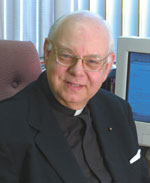The Transfiguration of the Lord /
Msgr. Owen F. Campion
The Sunday Readings
 This weekend, the Church invites us to celebrate the Feast of the Transfiguration of the Lord.
This weekend, the Church invites us to celebrate the Feast of the Transfiguration of the Lord.
The first reading is from the Book of Daniel. Times were terrible for the Jews when this book was written. Seldom had they been worse.
When Alexander the Great died in 323 B.C., his vast empire disintegrated and powerful generals took parts for themselves. The part seized by Seleucus was centered in Antioch and included the Holy Land. Decades passed. Seleucus himself died, to be succeeded by his descendants, one of whom, Antiochus IV, saw himself as divine.
Not only did Antiochus imagine that he was a god, but he brutally forced his subjects to worship him. Pious Jews refused. The Book of Daniel is about other Hebrew heroes who resisted idolatry, but the purpose of the book is clear: It was to rally Jews living under Antiochus IV to refuse to yield to the royal demands that they salute the king as a god.
In this reading, the prophet Daniel dreams of the world in which Almighty God is supreme, and all proclaim the greatness of God.
The Book of Daniel was written in part in code. This was done partly to veil the criticism of the authorities of the day.
The same method was used in the Second Epistle of St. Peter, which provides the second reading. This epistle appeared when times were bad, indeed fearful, for Christians. The Roman Emperor Nero could never be accused of timidity when it came to oppressing Christians.
He was the Antiochus IV of his day and time.
So, in calling believers to be steadfast in following Christ, the Epistle filled a genuine need, but for many early Christians, following Christ could be confusing.
Stories and legends, some probably developed with good intentions, others with less so, blurred the message of and about Jesus. This epistle insists that Christians listen to the true story of Christ as given them by the Apostles. The true story is the guide to salvation and is available. The Lord made it available by teaching and commissioning the Apostles.
The Gospel of St. Matthew’s revelation of the Transfiguration supplies the third reading. Jesus often faced demands for a sign from God that he was the Messiah. Skeptics inevitably raised these demands.
Jesus was not silent. This section of Matthew is filled with responses to these demands. Jesus fed the multitudes with five loaves and two fish. He walked on water. He healed the sick. He foretold the future. He forgave sinners, an action only available to God, since sin offended God in the last analysis.
Finally, dramatically, Jesus stood before Peter, James and John in the full radiance of divinity. He was God. He was the promised Messiah.
The Transfiguration profoundly placed Jesus, with a human nature and divine nature, before human vision.
Reflection
Throughout the history of God’s interaction with the Hebrew people, a variety of physical conditions indicated the divine presence: searing light, clouds from which God spoke, the devotion of the prophets, and again and again the people tried to climb as high as they could on mountains to be nearer to God.
All these conditions come together in the Transfiguration as Jesus appeared in resplendent, dazzling divine glory before these three Apostles. Peter, James and John saw Jesus as God.
The lesson was clear: Jesus was everything. Everything in creation, all the glories and hardships of the human condition, fell before the Lord.
For Christians through the long centuries, this story of the Transfiguration has been an anticipation of the ultimate glory of the resurrection, proof that Jesus is everything, and none is his equal. None equals the Lord in divine power. None equals Jesus in mercy, love, perfection and goodness.
Yes! He is the Savior. †
 This weekend, the Church invites us to celebrate the Feast of the Transfiguration of the Lord.
This weekend, the Church invites us to celebrate the Feast of the Transfiguration of the Lord.